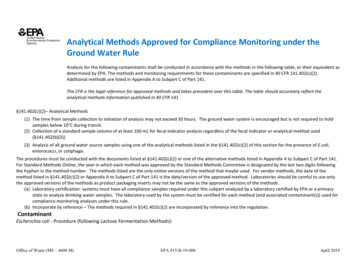
Transcription
AN INTRODUCTION TO THE METHODS OF WD. GANNBy Bryce Gilmore - www.bryce-gilmore.com.Author ofGeometry of Markets I & IIDynamic Time and Price Analysis of Market TrendsWaveTrader/CycleTrader Software.All the charts in this article were created using the WaveTrader/CycleTrader program.This is the uncut version of the article published inYOURTradingEDGEVol. 1 No. 5 November 1996William Delbert Gann (or as he preferred W.D. Gann) was apioneer in the area of time and price analysis of market activity.Born in Lufkin Texas in 1878, Gann's basic premise was thefuture is just a repetition of the past and that time governed allmarket movements.Gann traded with and taught time and price analysis methodsthat could predict market highs and lows. Gann reputedly hadthe knowledge to forecast the price and time of the yearly highand low for commodities and stocks.Each year Gann published a forecast for the following year. In1928 he published a forecast of the date of the September 1929US Stock Market High and that a Black Friday would occur AFULL YEAR IN ADVANCE.In 1932 he recommended buying stocks at the all time low in theDow in June and July.Gann died in 1955 leaving his partner in the publishing companyLambert-Gann, Ed Lambert, responsible for the Gannknowledge.In the 1960’s Billy Jones purchased what remained of Gann'spapers, charts and copyrights to his published works from EdLambert. It took a semi-trailer to remove all of it!! Billy has sincepassed away but his wife, Niki is now the custodian and has theGann material in safe keeping. Her address ishttp://www.wdgann.com/index.htm1878-1955W.D. Gann, both a keen trader and a workaholic, published many books the titles were:
The Truth of the Stock TapeHow to Make Profits from Puts and CallsTunnel through the AirMagic WordHow to Make Profits in Commodities45 Years In Wall Street and New Stock Trend Detector As well he produced manyinstructional courses on trading later compiled by Billy Jones into 2 trading courses;The W.D. Gann Commodity Course and the W.D. Gann Stock Market Course.Gann was a prolific researcher throughout his lifetime with interests in numerology,weather forecasting and astrology. A very religious man and a 33rd degree mason, Gannclaimed he learnt about forecasting price movements from the Bible. His knowledge ofmathematical and astrological relationships was very advanced. He used this knowledge toformulate trading and technical analysis techniques which students could follow to identifysupport and resistance levels for most free trading markets.Gann and the creator of Elliott Wave theory - R.N. Elliott - shared some similar beliefsabout market activity. Gann believed that Bull or Bear campaigns took 3 or 4 sections tocomplete the move. Elliott believed that there were 3 impulse waves in a Bull or Bear trend,with the possibility of an extended 5th Wave to give Gann’s 4th section. Gann believed thatmarkets most commonly retraced 1/2 (50%), 5/8s (62.5%) or 3/8s (37.5%) of the previousrange. Elliott believed that markets most commonly retraced 61.8%, 50 % or 38.2% of theprevious range.Gann had an arsenal of price tools he taught students and it was reputed he charged 5000 for a weekend course in the early 1950’s, before his death in 1955. This article willcover many of Gann’s important time and price tools. Other tools such as The Square ofNine, Square of 144, Square of 90, Hexagon Chart and Gann’s various Master Calculatorswill be covered in future articlesGann's books are required reading for any trader or analyst who wishes to understand thebasic ways to view any market. The knowledge outlined in his works can easily beoverlooked due to the abundance of information he presented. Just the same the pattern ofinformation remains identical throughout all of his published work. Gann always said"History Repeats" and repetition was his way for students to get the message.Gann’s work included Money Management Rules and Trading Psychology conceptsexpounded by many of today's top traders. He believed that you did not have to be in themarket all the time to make money. Here are some quotes from W.D. Gann taken from hislast book, How to Make Profits in Commodities. Page 11. Published by Lambert-Gann."TIME TO STAY OUT OF THE MARKET: This is something important for everyone toknow. You cannot make money by trading in the market every day or by getting inand out every day. There comes a time when you should stay out, WATCH and WAITuntil you determine a DEFINITE CHANGE IN TREND. Long periods of rest andrelaxation protect your health and help your judgment which will result in profitslater.""THE BEST WAY TO TRADE: The most money is made by swing trading, or in thelong pull trades, that is following a definite trend as long as the market trend is up ordown, you must learn by rules to wait until the market gets out of a rut or a tradingrange. Wait for a definite indication that it is going higher or lower, before you take a
position for a long pull trade. Always figure that YOU CAN BE WRONG and that themarket could reverse. Therefore, follow your profits up with a STOP LOSS ORDER,or get out when you get a definite indication that the market has reached a turningpoint and that the trend is changing."As a picture is worth a thousand words we will now look at some charts. Please examineeach chart closely as there are some important points on them.Gann's main trading philosophy was to trade with a close stop loss and select the mostopportune trades in the direction of the main trend. To confirm a trend was in progress, hewould look for lower highs and higher lows to form after a major reversal in trend. Themethod he used to monitor trends and filter out any random market noise was the SwingChart. Figure 1 shows an example of a Swing chart. After July 30 1996 Gann would havesaid the trend in the SPI was up as it was making higher lows and higher highs. Gannwould be a buyer of the SPI from 2170.Gann placed a lot of importance on the daily price patterns. He talked at length on thedifferent types of reversal patterns you can use to identify an imbalance between supplyand demand.Figure - 2 shows some of the bar chart patterns Gann looked for to confirm turning pointsor to get him out of trades quickly with minimal loss.
Gann taught students to face the facts and eliminate hope and fear. For instance, if atrader receives a margin call, he should close the position immediately, for the chances arehe is wrong. He also taught that a successful trader studies human nature and does theopposite of what the general public does. Most traders lose money because they are toogreedy, they over trade, they expect abnormal profits in normal markets.Gann's analysis techniques for predicting major market tops and bottoms were based oncycles. Gann believed that the future was only a repetition of the past. Gann maintainedthat as each new generation exerted its influence on the markets similar bull and bearmarkets would unfold.Gann's 20 year cycle relies on the fact that human nature never changes. Therefore aseach new generation came to power they would behave similarly. Their inexperience inspeculation would cause markets to rise and fall to prices unwarranted by supply anddemand. The result is that when the BOOM is over, the young generation suffer severelosses, get some valuable experience and are not eager to try it again. To predict a top orbottom for the year Gann would look at the market activity in the years back 10, 20, 30, 40,50, 60 and 100 years for similar conditions.The first basic technique Gann taught students was to watch anniversary dates with pastmarket tops and bottoms for a change in trend. When it came to shorter term analysis oftime, Gann devised a system of counting off time in solar degrees of a year from pastmarket tops and bottoms. He counted divisions of the year in eighths and thirds. Whenclusters of time counts from past tops and bottoms highlighted a future date, that date wassignificant for a reversal of trend.Figure -3 shows the major anniversaries in the All Ordinaries
The cycle of one year has 365 days. The circle of one year has 360 degrees. The Earthrevolves around the Sun in an elliptical path moving closer to and away from the Sunduring its orbit. This is the reason the days and degrees relationships speed up and slowdown. To explain, there are 4 cardinal points in the circle, 90, 180, 270 and 360 degrees.As the Earthmoves around theSun the daylighthoursprogressively getlonger andshorter every sixmonths. Theshortest day ofthe year in theSouthernhemisphere isJune 21, (in theNorthernhemisphere it'sthe longest day),the shortest dayis known as theWinter Solstice(this is 270o). Thelongest day of theyear is December22, 90o, thesummer solstice.ooSeptember 21 (360 ) and March 21 (180 ) are the days when daylight and darkness areequal, these are the Equinoxes.The four seasons of the year evolve around these 4 points. Some people may recognise
these cardinal points at angles 180 degrees opposed to this explanation.Refer to Figure - 4 and note that the 2310 high in late August 96 came on 1.75 (1 and 3/4years) x 360o or 630o solar degrees from the November 23 1994 Low at 1793.It is important to realize that the Earth takes 179 days to move from 0o to 180o around theSun. Yet, it takes 186 days to move from 180o to 360o around the Sun.The two points in the circle, of one year, where the relationships between days anddegrees begin speeding up and slowing down are the perigee and the apogee. Theperigee (distance to the Sun is closest) occurs about January 3 each year, the apogee(distance to the Sun is furthermost) occurs July 4 each year.When comparing cycles it is preferable to work in degrees for greater accuracy, for this youneed to use an ephemeris or a computer program, such as CycleTrader, capable ofcalculating degrees precisely.Gann developed a unique method of squaring price to time and time to price. He taughtthat every stock or commodity maintained a vibration where there was a relationshipbetween 1 degree of price to 1 degree of time. The difficulty with many stocks andcommodities is in finding what value represents 1 degree of price. For the purposes of thisdemonstration I have used the All Ordinaries Index and used 1 unit of price to 1 unit oftime.A market can square price to time in several different ways.1. Price units in a trend equal time units in a trend.2. Base price equals time units to a new change in trend.
3. Prior price range equals times units to a new change in trend.4. Prior time units equals next price range to a new change in trend.5. Current price equals time units from a prior change in trend. (zero angle).To keep a track of the position of his price to time he would draw GANN ANGLES up fromlows and down from highs. He also used 4 to 1, 2 to 1, 1 to 2 and 1 to 4 angles. 1-4 means1 unit of time to 1/4 unit of price.If you study Figure 5 carefully you will see an example of each of the methods Gann usedto determine when a change in trend could eventuate.Gann placed extreme importance on squaring between price ranges, these could beretracement levels or alternating campaigns. The All Ordinaries Index between 1991 and1994 is a perfect example of squaring between price ranges.See Figure - 6. Range 2 is 2 times range 1.
The example in Figure - 7 epitomizes everything about Gann's knowledge of order withinthe market. The time by degrees in each alternate trend "squared" between extreme topsand bottoms. This example should get any trader's or analyst's attention.
When I first read Gann's words, "Time is the most important indicator. When time is up themarket must change trend." I crossed the threshold of market knowledge, inspired to learnmore.Ever since, I have been rewarded with a knowledge allowing me the patience to wait forthemajor setups to trade. The principals illustrated here will work with all degree of markettrends, anything from 7 days to 5 years.Most analysts should be familiar with price retracement levels acting as support orresistance between trends of similar degree. Gann taught his students to measure priorprice ranges and divide them into 1/8ths and 1/3rds, these levels can act as support in adowntrend or resistance in an uptrend. When a market reaches these levels and reverses,all the trader has to do to verify a trend change is to look for a clustering of time cycles onthat day. Gann angles also determinetime & price intersections. Figure - 8 shows the recent 2086 low in the SPI on July 17achieving an exact 50% retracement and the March 11 post election panic low at 2158 wason a 37.5% retracement.
The day of 17th July 1996 when the SPI reversed trend on the 50% retracement of all thegains made between 1994 and 1996 there were several important time cycles peaking. Ihave shown 2, the time between the major lows in 1991 and 1992 was cycling 2.00 timesand the time between the 1992 low and the 1994 high was cycling 2.00. It is quite amazinghow the market continues to vibrate between highs and lows in a pure geometric form.Most people do not realize how easy it is to identify time cycles in advance.The charts in this article were prepared using my personal WAVETRADER /CYCLETRADER SOFTWARE. I designed and programmed this software to give me theadvantage I needed to beat the market. I have continually revised and upgraded mysoftware over years of new experiences. Now in 1996 I feel I have finally produced a toolthat gives me total control over my own trading destiny. Along the way I have made thesoftware available to other traders, and have been amply rewarded from their input. I havefound over the years there are a continuous number of new people entering the marketand losing money, some depart, others regroup and try to learn methods that will makethem successful traders. The bottom line nevertheless is each trader needs tools andmethodologies from which to formulate a low risk trading plan, one to follow mechanicallywhere the trade selection process remains similar. Once the trade selection process isautomated into a systematic approach, then the trader needs to have a workable moneymanagement plan to ensure success.Gann summed it up best with a set of rules to follow, his bottom line though was, "Do nottrade on guesswork or gamble on hope. Knowledge brings profits. Never trade withoutSTOP LOSS ORDERS."I hope these brief and limited examples of technical analysis methods illustrate what ispossible, if you do a little work.Bryce T. Gilmore
.Bryce Gilmore is a private trader, analyst and the designer of the WaveTrader-CycleTrader software. Thesoftware saves hours and weeks implementing every known time and price method attributed to the works ofW.D. Gann and R.N. Elliott. The software operates with MetaStocktm format and CSIM data base and comeswith a comprehensive 100 page manual.Bryce also conducts occasional seminars on the Gold Coast of Queensland to teach peoplehow to analyze markets for themselves.To purchase the WaveTrader/CycleTrader or any of Bryce's books or for more information on the Seminar callBryce at Gold Coast, Australia Intl 61-7- 5573 2283 (locals use 07) or emailgilmore@qldnet.com.au or see www.bryce-gilmore.com.[C] 1999 Bryce Gilmore & Associates Pty Ltdwww.bryce-gilmore.com
support and resistance levels for most free trading markets. Gann and the creator of Elliott Wave theory -R.N. Elliott -shared some similar beliefs about market activity. Gann believed that Bull or Bear campaigns took 3 or 4 sections to complete the move. Elliott believed that there were 3 impulse waves in a Bull or Bear trend,











